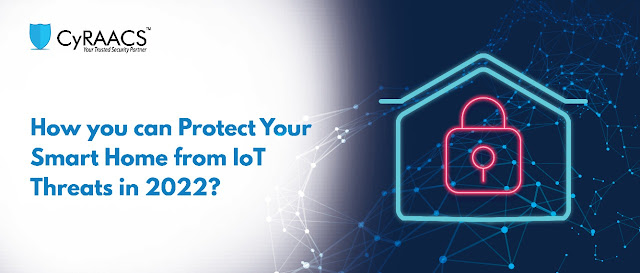How you can Protect Your Smart Home from IoT Threats in 2022?
Our world is becoming increasingly digital as we become more interconnected through a web of devices and technology. This collection of things, software, and services that we interact with on a daily basis is called the Internet of Things (IoT) which are also commonly referred to as smart homes for their ability to automate our lives for us, keeping us out of danger at all times so that we can focus on other tasks at hand without having to worry about getting hurt or encountering danger itself.
As a smart homeowner, you're probably wondering how you can
protect your smart home. Here are a few things you might want to consider:
1. How Can You Secure Your Wi-Fi Network?
Most of your smart home devices are connected to a Wi-Fi
network, so it's crucial the network is secured and encrypted. While there are
multiple methods to go about securing a Wi-Fi connection, one option is by
purchasing a quality router with strong encryption from a reliable brand.
Often, due to improper enhancements, some routers have been known to no longer
work properly as soon as you try to access them through certain WiFi-enabled
devices such as iPhones or Androids. A good alternative that can deliver
similar or even better results involves replacing the network name and login
credentials with ones generated randomly to eliminate potential security risks.
If your router allows you to set up multiple networks, then
you can create two networks – one that's closed and another that's open. This
kind of segregation is a good security measure and a good way to secure your
Wi-Fi at home.
2. Shutdown Your Unused Devices
A common mistake that homeowners make is to not check each
and every device connected to their network. This way you can turn people off
when they’re not needed so you won’t be wasting energy by leaving them on all
the time. You may discover some devices such as a security camera for example
haven’t been used in a long time and are only taking up space, making your home
less secure. Switch these IoT devices off at the wall or disable them by
clearing any saved information if possible.
Many smart home devices aren't used regularly but can still
be turned on unintentionally. Leaving them active in this state becomes an easy
target for any hacker with malicious intent and they may try to exploit the
security vulnerabilities of these devices, so make sure you unplug them to
prevent this from happening!
3. Use Dedicated IoT (Internet of Things) Security
Devices
IoT devices are becoming increasingly popular, which has
created a need for better security on one's home network. To meet this need,
many cybersecurity advisory &
consulting services have introduced smart home devices that protect the
home network from cyber threats such as malware, identity theft, etc. Most of
these security devices only work with other smart home devices and they also
include features like VPN protection to further ensure improved digital safety
of one's personal data.
4. Regularly Update Firmware on Your Devices
Almost all of your smart home devices run on firmware, which
is basically the main software that powers the hardware. Updating this software
is important so that you are able to benefit from new features introduced by
the manufacturer and also handle any security flaws or threats in advance.
Unfortunately, many manufacturers do not make firmware updating one of their
top priorities and it's often left out entirely when initially launching a product.
That's why it's extra important to watch manufacturer-produced tutorials on how
you can apply updates yourself if and when they are available at some point
down the line.




Comments
Post a Comment